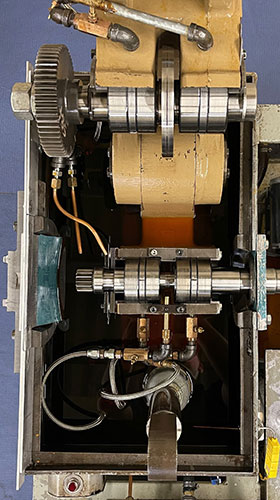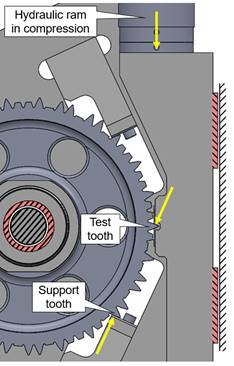Facilities at Penn State
The Gear Research Institute is a non profit corporation registered in the state of Pennsylvania. It has contracted with the Applied Research Laboratory of The Pennsylvania State University to conduct its activities, as a sponsor within the Drivetrain Technology Center. The Gear Research Institute is equipped with extensive research capabilities. These include rolling contact fatigue (RCF) testers for low- and high-temperature roller testing, power circulating (PC) gear testers for parallel axis gears with a 4-inch center distance (testers can be modified to accommodate other center distances), single tooth fatigue (STF) testers for spur and helical gears, gear tooth impact tester, and worm gear testers with 1.75 and 4-inch center distances. Extensive metallurgical characterization facilities are also available at Penn State in support of the Gear Research Institute. Below are examples of several of our test rigs. If you would like further details on our testing capabilities please go to the Drivetrain Technology Center website.
Power Circulating (PC) Bending Fatigue Gear Test
Bending strength (tooth breakage) tests are conducted on a four-inch center distance test rig. The standard operating speed for these rigs is 1800 RPM. Specimen and mate gears can be identical (i.e., ratio of 1:1) allowing for two identical tests to be conducted at the same time. Alternatively, a non 1:1 ratio can be used with torque reversing gears installed in the gear box on the drive motor end of the machine. A general overview of a 4-inch center distance test rig is shown in Figure A3-1. By modifying the bearing bars, other center distances can be accommodated and even helical gears can be tested.
Power Circulating (PC) Surface Durability Gear Test
PC surface fatigue, scuffing resistance and loss of lubrication tests are conducted on high-speed 3½ inch center distance test rigs. The operating speed for these rigs is variable up to 10,000 RPM. Unlike the low-speed rigs used in PC bending strength tests, the 3½ inch center distance rigs apply load as the gears are running. Torque is measured and controlled by a torque cell built into the power re-circulating loop. These rigs are instrumented to measure test box friction, vibration and out of mesh lubricant temperature. Algorithms have been developed in conjunction with faculty at ARL Penn State for early failure detection. The specimen (driving gear) and mate (driven gear) are identical; thus, two gears are required per test. The torque reversing gears are precision double helical gears that are permanent parts of the test rig.
Rolling Contact Fatigue (RCF) Test
This test simulates the rolling/sliding action that occurs in a gear mesh. The image below shows a picture of the RCF test rig. The specimen and load rollers are cylindrical. The outside diameter of the load roller is crowned to concentrate the load at the center of contact, and eliminate the possibility of concentrated loading at the edge of contact due to misalignment. A normal load is applied by air pressure. Phasing gears, attached to the shafts on which the specimen and load rollers are mounted, control the extent of sliding at the specimen/load roller interface. The result of the test is stress-life data comparing the contact fatigue performance of various populations. Rolling/sliding tests can be conducted up to temperatures of 400°F.

Single Tooth Bending Fatigue (STBF) Test
In single tooth fatigue testing load is applied at a fixed location on one tooth and supported at a fixed location on another tooth. Care is taken in the design of the load and reaction blocks to ensure that contact stresses at the points of contact are low enough to avoid surface durability failures. Thus failure will only occur by bending. Testing frequency can reach 65 hertz with tooth loads up to 110,000 lbs. Utilizing different fixtures, a large variety of spur, helical, bevel, spiral bevel (see image below), and face gears can be tested for bending fatigue.

Single Tooth Reversible Bending Fatigue (STRBF) Test
Similar to STBF testing but GRI has developed the methodology (and modular hardware) to allow load reversal on the test tooth. Any stress reversal ratio can be achieved. This test is used to generate bending fatigue data applicable to idler and planet gear applications. A generic schematic is shown below.

